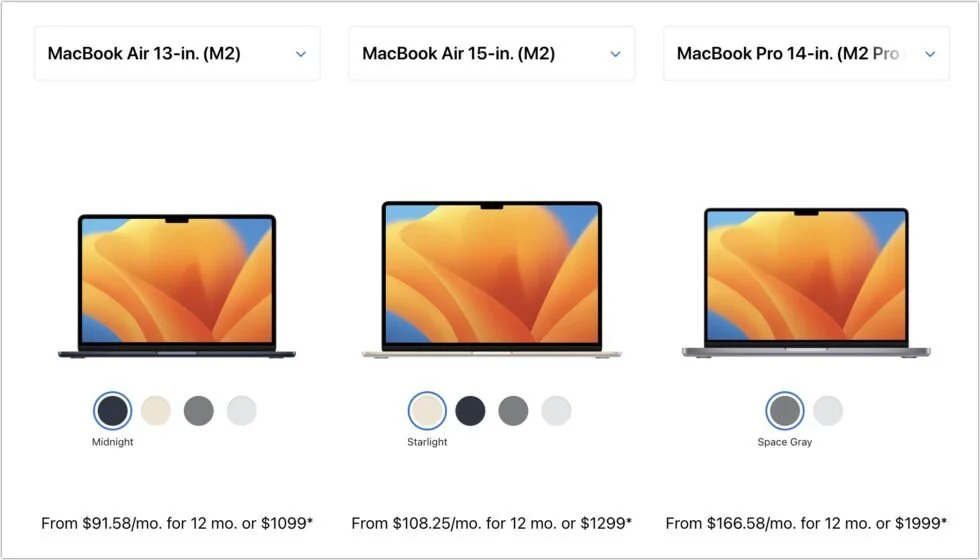Choosing the Best Mac for a College-Bound Student in 2023
Do you have a child starting college soon? It’s likely that your kid has been relying heavily on a computer throughout high school, but if it was a school-provided laptop or shared family computer, now’s the time to get them something of their own. Even if they had their own laptop throughout high school, if it’s old or unreliable, college is a good excuse to bring them up to date. If you haven’t been paying close attention to Apple’s Mac lineup, you might wonder which model makes the most sense.
First, don’t buy anything without first checking with the college. Many college departments have specific requirements based on the software students use in their classes. Generally, these revolve around processor type, amount of RAM, and storage space. Current Macs should meet or exceed all those requirements. Second, see if the college provides access to education pricing—most will—to save a few hundred dollars off the prices listed below. Regardless, Apple often has a Back to School offer.
Colleges often specify—and students usually prefer—laptops instead of desktop machines. Although the M1 24-inch iMac is an excellent machine with a gorgeous screen, it’s too big and unwieldy for the nomadic lifestyle of the typical college student. The same applies to an M2 Mac mini or Mac Studio with an external display. Students can take a laptop to class daily, and bringing it home on breaks is a lot easier. A student accustomed to taking notes on an iPad with a keyboard and Apple Pencil might be able to use that along with a desktop Mac, but most students should focus on laptops.
In the past, deciding which model was best for a given student was more challenging, but Apple’s move to the speedy and power-efficient M1 and M2 chips makes the decision easier. We see three primary scenarios:
Most students: Buy Apple’s MacBook Air. It’s Apple’s lightest and least expensive laptop. Within the MacBook Air line, you have three choices. The least expensive is the 13-inch M1 MacBook Air from 2020, which starts at $999, but the 13-inch M2 MacBook Air is a better choice for most people, thanks to its bigger-brighter-better 13.6-inch screen, faster performance, 24 GB memory ceiling, and higher-resolution webcam. It now starts at $1099. Those who want a larger screen should look at the just-released 15-inch M2 MacBook Air, which starts at $1299. Apart from the 15.3-inch screen, the only difference from the 13-inch model is a six-speaker system, up from four speakers.
Better specs: If performance is more important than cost—especially if your student will be working with processor-intensive tasks like video editing—look to the 14-inch MacBook Pro. It features a powerful M2 Pro chip or an even faster M2 Max chip, and it can be configured with more memory. Although its 14.2-inch screen is physically a little smaller than that of the 15-inch MacBook Air, it has a somewhat higher resolution. Its price starts at $1999.
Windows compatibility: The only downside of the transition to Apple silicon is that it’s somewhat more difficult to run Windows using virtualization software like Parallels Desktop (half-price for students and officially supported by Microsoft) or VMware Fusion (free for students but much harder to set up and not officially supported by Microsoft). If Windows compatibility is a bonus but not essential, Parallels Desktop and Windows 11 on Arm should work. However, if Windows compatibility is paramount, your choices are a used Intel-based MacBook Pro or—much as we hate to say it—a PC laptop that runs Windows natively.
Regardless of which laptop you decide on, you’ll have to pick a processor, amount of memory, and storage capacity:
Processor: With the 13-inch M1 MacBook Air, you’re limited to the M1 chip with an 8-core CPU and 7-core GPU. With the 13-inch M2 MacBook Air, the M2 chip always has an 8-core CPU, but you can pay $100 to upgrade from an 8-core GPU to a 10-core GPU. The 15-inch M2 MacBook Air always comes with a 10-core GPU. The performance difference isn’t likely noticeable with everyday apps, but for $100, it might be worth upgrading, just in case. The 14-inch MacBook Pro has two M2 Pro options and two more M2 Max options, and choosing between them is probably best done by weighing likely performance needs against the (significantly) increased cost.
Memory: The 13-inch M1 MacBook Air offers the choice of 8 GB or 16 GB. 8 GB is acceptable for most college students, but we’d encourage 16 GB to reduce the chance that memory becomes a limiting factor in performance. The M2 MacBook Air lets you choose from 8 GB, 16 GB, or 24 GB, and again, we’d default to 16 GB unless there’s some particularly memory-hungry software in play. With the 14-inch MacBook Pro, the amount of memory goes with the chip. The M2 Pro comes with 16 GB standard, but you can opt for 32 GB. With the M2 Max, 32 GB is standard, with options to upgrade to 64 GB or 96 GB.
Storage: For all the MacBook Air models, 256 GB is the lowest storage level, and you can upgrade to 2 TB. The 14-inch MacBook Pro starts at 512 GB and offers upgrades up to a whopping 8 TB. Choose the amount of storage based on two considerations: budget (it gets expensive fast) and anticipated usage (audio and especially video can consume a lot of space, as can large numbers of photos, but most other uses don’t). Remember that it’s easy to connect an external Thunderbolt SSD or hard drive to offload large files that don’t have to be kept available at all times. Large files can also be kept in cloud-based storage.
To our thinking, the most obvious choice for a Mac that’s likely to last for four years of college would be either the 13-inch or 15-inch M2 MacBook Air with a 10-core GPU, 16 GB of memory, and 512 GB of storage. Be sure to budget for AppleCare+, too; it’s almost guaranteed that some mishap will befall a student laptop, and AppleCare+ covers up to two incidents of accidental damage every year.
You’ll need to have some conversations with your child to find out what they think they’ll need—and be sure to double-check that against the college’s recommendations—but if you have any questions after that, don’t hesitate to contact us.
(Featured image by Apple)


